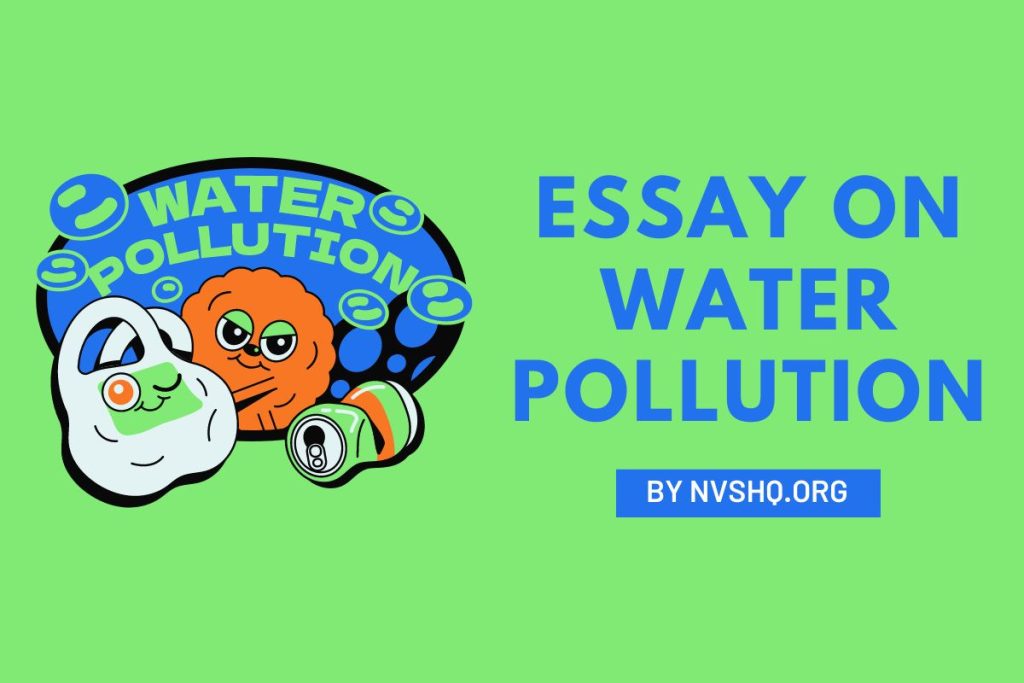Essay on Water Pollution: In this article, we have provided the template for the essay on Water pollution for students and children. In this essay, we will discuss the causes and effects of water pollution and explore ways to prevent and control it.

Essay on Water pollution for students and children
Introduction
Water pollution is a major environmental problem that affects the health and well-being of people, animals, and plants. Water pollution is simply defined as any unwanted material in the source of water bodies. It is the contamination of water bodies such as rivers, lakes, oceans, and groundwater by pollutants that degrade water quality and make it unsafe for use. Water pollution is majorly caused by anthropogenic activities which degrade the quality the of water available for human consumption.
Around 72% of Earth’s surface is covered with water but only a few per cent of it is available for drinking and human consumption and is being polluted by human activities like dumping wastes into a fresh source of water like rivers which ultimately pollutes the ocean. Not only humans are the victim but loss of habitat for many species and life is also seen.
Causes of Water Pollution
Human activities are the main causes of water pollution. With the advancement of science and technology and the growing population practices like improper industrial and agricultural practices, improper waste disposal, and sewage discharge are among the major contributors to water pollution. Industrial facilities often release their untreated waste material, toxic chemicals and heavy metals into water bodies, contaminating the water and making it unsafe for use.
Similarly, agricultural practices such as excessive use of fertilizers and pesticides can contaminate water with harmful chemicals. Water is the universal solvent when get mixed with pesticides and different other chemicals used in agriculture practice infiltrate down and reach the underground water table, making it contaminated and unsafe for human consumption.
Improper waste disposal, such as the dumping of trash and chemicals into rivers and lakes, also leads to water pollution. Chemicals like mercury and microplastic reach the water bodies and enter the food chain which results in severe diseases like mimamata. Finally, sewage discharge from residential areas and factories can introduce disease-causing microorganisms into water bodies, posing a serious threat to public health.
Effects of Water Pollution
The effects of water pollution are far-reaching and can have serious consequences for both the environment and human health. Through contaminated water, heavy metals enter the food chain at lower levels and get accumulated in the higher level organisms causing many diseases and disorders. Polluted water can harm aquatic life by destroying habitats and killing fish and other organisms.
Different marine organisms come in contact with heavy metals which kills them and disturbs the environment. It can also reduce the availability of safe drinking water, which can lead to water-borne diseases such as cholera, typhoid, and dysentery, especially in those areas where proper hygiene is not given importance. Additionally, water pollution can damage crops and other agricultural products, resulting in economic losses for farmers and food shortages for people.
Prevention and Control of Water Pollution
Preventing and controlling water pollution requires a collaborative effort from individuals, organizations, and governments. This can be achieved through different methods some of the measures that can be taken to prevent water pollution are as follows:
- Proper waste disposal: All waste should be properly disposed of in designated locations. Hazardous waste should be taken to special facilities for disposal. People should be responsible and should not throw garbage except in properly designated places.
- Reduce the use of chemicals: Reducing the use of chemicals such as fertilizers, pesticides, and industrial chemicals can help to reduce water pollution. Agriculture practices should be promoted where minimum to minimum use of chemicals should be used. Organic farming should be promoted. Using environmentally friendly products such as biodegradable soaps and detergents can help to reduce water pollution. Heavy paints and other products which contain heavy metals should be properly disposed of.
- Improved sewage treatment: Proper sewage treatment plants should be set up to clean the water and make it safer and reusable for human consumption. Sewage should also be treated before being discharged into water bodies. This can help to remove harmful microorganisms and other pollutants from the water like metals and carcinogenic particles.
- Awareness and education: Most important of all, people should be educated about the consequences of water pollution as at lower levels individuals too cause water pollution. Education and awareness campaigns can help to educate people on the dangers of water pollution and how they can help to prevent it. In addition to these measures, governments can also enact laws and regulations to control water pollution. Such laws can help to regulate the discharge of pollutants into water bodies and provide penalties for those who violate the regulations.
Conclusion of Essay on Water Pollution
Water pollution is a serious environmental problem that requires immediate attention from individuals, organizations, and governments. The causes of water pollution are mainly human activities, and the effects can be devastating to both the environment and human health. Preventing and controlling water pollution requires a collaborative effort from everyone, and measures such as proper waste disposal, reduction of chemical use, use of environmentally friendly products, improved sewage treatment, and education and awareness can go a long way in preventing and controlling water pollution.





